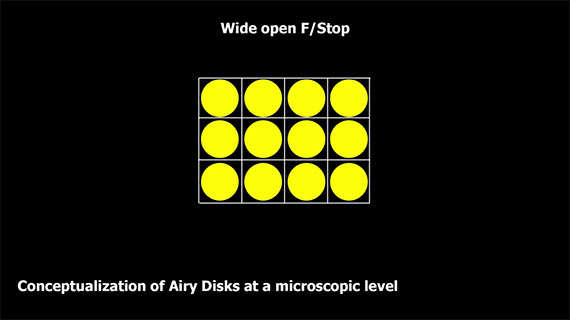Lens diffraction is something that every landscape photographer has to deal with. Whether you’re using a top of the line lens or a very cheap one, lens diffraction is undeniably going to impact your images. So, what is lens diffraction? Photographer Steve Perry explains:
“When a light wave hits an obstacle like the edge of an aperture blade, it starts to disperse. This has the effect of changing the various wavelengths so that they travel different distances and they begin to interfere with each other. When this happens there is a loss of sharpness.”
This is lens diffraction. The smaller the lens opening, the softer the image becomes.
This is probably best understood using the airy disk analogy. Think of an image as being composed of numerous small pinpoints of light. When the aperture is big, the points of light are not diffracted and the projected dots of light are sharp and clean.

Larger f-stop produces a clear image devoid of diffraction
As the aperture is stopped down, diffraction sets in and the airy disks begin to blur and merge, meaning your image becomes soft.

Smaller f-stop results in diffraction, resulting in image softness
Though all lenses are prone to the effects of diffraction, lower resolution sensors tend to get affected by diffraction much later. This is because with tiny packed sensors (higher resolution) even a small amount of blurring of the air disks means they overlap. This is why with lower resolution cameras (pixels not closely packed) you can easily use the lens stopped down to another one to two full stops before you experience a similar loss of sharpness.
Image sharpness and depth of field are not the same thing. Though smaller f-stops give you a bigger depth of field (more of the frame in focus), actual image sharpness actually decreases.

The sweet spot of a lens produces the biggest depth of field with minimum diffraction
Another tip—if you stop down the lens to about one to two stops from wide open, you’ll get better sharpness; chromatic aberration and other imperfections tend to get corrected when you stop a lens down one to two stops.
Lens diffraction shouldn’t deter you from using a smaller f-stop. But you should be aware of the downsides. Ideally, you should always try get the balance right between depth of field and image sharpness.
Like This Article?
Don't Miss The Next One!
Join over 100,000 photographers of all experience levels who receive our free photography tips and articles to stay current:






chlngr – Diffraction is not a theory, it is proven and can be proven by nearly anyone. Even you. The spreading of light as it passes through an aperture is a basic physics experiment, and it does apply to lenses. If your camera has large numbered f-stops, like f/16, f/22, f/32, you can see it yourself.
That’s a concept – a theory. An incorrect theory.
A lens is not composed of numerous small pinpoints of light. If it were, the theory might hold water. But a lens does not admit numerous small pinpoints of light. It “sees” one chunk.
This is something to be considered, but let’s not fall into the trap of believing everything posted on the internet.
The diffraction is the same for all three cases. The difference is that the lowest f number case cuts out the diffraction orders (1,2…) that make the image resolution.